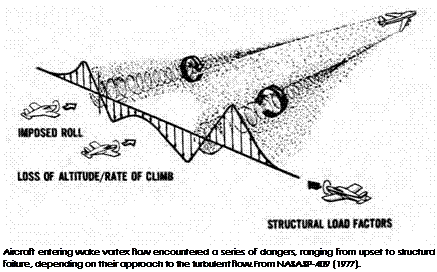Spin Research
One of the areas of greatest interest has been that of spin behavior. When an airplane stalls, it may enter a spin, typically following a steeply
descending flightpath accompanied by a rotational motion (sometimes accompanied by other rolling and pitching motions) that is highly disorientating to a pilot. Depending on the dynamics of the entry and the design of the aircraft, it may be easily recoverable, difficult to recover from, or irrecoverable. Spins were a killer in the early days of aviation, when their onset and recovery phenomena were imperfectly understood, but have remained a dangerous problem since, as well.[840] Using specialized vertical spin tunnels, the NACA, and later NASA, undertook extensive research on aircraft spin performance, looking at the dynamics of spins, the inertial characteristics of aircraft, the influence of aircraft design (such as tail placement and volume), corrective control input, and the like.[841]
As noted, spins have remained an area of concern as aviation has progressed, because of the strong influence of aircraft configuration upon spin behavior. During the early jet age, for example, the coupled motion dynamics of high-performance low-aspect-ratio and high-fineness-ratio jet fighters triggered intense interest in their departure and spin characteristics, which differed significantly from earlier aircraft because their mass was now primarily distributed along the longitudinal, not lateral, axis of the aircraft.[842] Because spins were not a normal part of GA flying operations, GA pilots often lacked the skills to recognize and cope with spin-onset, and GA aircraft themselves were often inadequately designed to deal with out-of-balance or out-of-trim conditions that might force a spin entry. If encountered at low altitude, such as approach to landing, the consequences could be disastrous. Indeed, landing accidents composed more than half of all GA accidents, and of these, as one NASA document noted, "the largest single factor in General Aviation fatal accidents is the stall/spin.”[843]
The Flight Research Center’s 1966 study of comparative handling qualities and behavior of a range of GA aircraft had underscored
the continuing need to study stall-spin behavior. Accordingly, in the 1970s, NASA devoted particular attention to studying GA spins (and continued studying the spins of high-performance aircraft as well), marking "the most progressive era of NASA stall/spin research for general aviation configurations.”[844] Langley researchers James S. Bowman, Jr.; James M. Patton, Jr.; and Sanger M. Burk oversaw a broad program of stall/spin research. They and other investigators evaluated tail location and its influence upon spin recovery behavior using both spin-tunnel models,[845] and free-flight tests of radio-controlled models and actual aircraft at the Wallops Flight Center, on the Virginia coast of the Delmarva Peninsula.[846] Between 1977 and 1989, NASA instrumented and modified four aircraft of differing configuration for spin research: an experimental low-wing Piper design with a T-tail, a Grumman American AA-1 Yankee modified so that researchers could evaluate three different horizontal tail positions, a low-wing Beech Sundowner equipped with wingtip rockets to aid in stopping spin rotation, and a high-wing Cessna C-172. Overall, the tests revealed the critical importance of designers ensuring that the vertical fin and rudder of their new GA aircraft be in active airflow during a spin, so as to ensure their effectiveness in spin recovery. To do that, the horizontal tail needed to be located in such a position on the aft fuselage or fin so as not to shield the vertical fin and rudder from active flow. The program was not without danger and incident. Mission planners prudently equipped the four aircraft with an emergency 10.5-ft – diameter spin-recovery parachute. Over that time, the ‘chute had to be deployed on 29 occasions when the test aircraft entered unrecoverable
spins; each of the four aircraft deployed the ‘chute at least twice, a measure of the risk inherent in stall-spin testing.[847]
![]()
 |
NASA’s work in stall-spin research has continued, but at a lower level of effort than in the heyday of the late 1970s and 1980s, reflecting changes in the Agency’s research priorities, but also that NASA’s work had materially aided the understanding of spins, and hence had influenced the data and experience base available to designers shaping the GA aircraft of the future. As well, the widespread advent of electronic flight controls and computer-aided flight has dramatically improved spin behavior. Newer designs exhibit a degree of flying ease and safety unknown to earlier generations of GA aircraft. This does not mean that the spin is a danger of the past—only that it is under control. In the present and future, as in the past, ensuring GA aircraft have safe stall/spin behavior will continue to require high-order analysis, engineering, and test.










